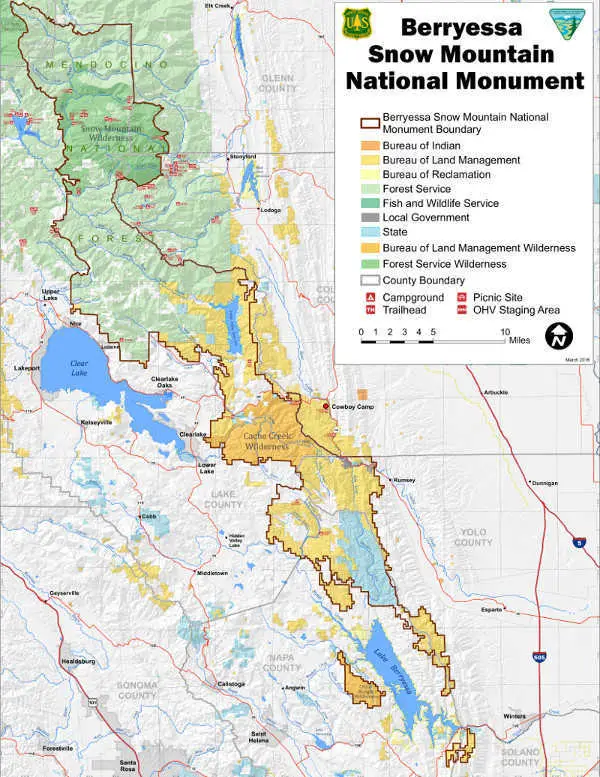
LUCERNE, Calif. – The Lucerne Town Hall has formally recognized the town of Lucerne as Gateway to the Berryessa Snow Mountain National Monument.
The unanimous vote Thursday makes Lucerne the first Northern California town adjacent to the monument to officially declare gateway status since the monument was created July 10, 2015.
“Many people are not aware that the Berryessa Snow Mountain National Monument is right behind District 3 towns,” said District 3 Supervisor EJ Crandell, who was on hand for Thursday night’s town hall meeting and himself a Northshore native who now lives in Lucerne. “This initiative provides Lucerne yet another auspicious vantage point for families and travelers to visit our beautiful town and county. “
The monument is composed of 330,780 acres of the California Coast Range in Napa, Yolo, Solano, Lake, Colusa, Glenn and Mendocino counties. The Cache Creek Wilderness is located within the monument.
Two-thirds of the monument is within Lake County’s boundaries alone, and Lucerne sits at roughly the midpoint of the monument’s vast acreage.
President Barack Obama established the monument in 2015 by presidential proclamation. The proclamation details the diversity of the area including the unique geology, flora and fauna found within its boundaries.
“Rising from near sea-level in the south to over 7,000 feet in the mountainous north, and stretching across 100 miles and dozens of ecosystems, the area's species richness is among the highest in California. This internationally recognized biodiversity hotspot is located at the juncture between California's Klamath, North Coast, and Sacramento Vallejo ecoregions and provides vital habitat and migration corridors for diverse wildlife, including several endemic plant and animal species,” the proclamation states.
Its formation gained the support of local organizations and governments, including the Board of Supervisors, which approved a proclamation in June 2017 reaffirming its support when President Donald Trump signed an executive order to review the formation of the Berryessa Snow Mountain National Monument and 21 others across the nation – six of them in California – that had been formed by previous president under the Antiquities Act, as Lake County News has reported.
The national monument was championed by the nonprofit organization Tuleyome, which lobbied for national monument status and held meetings about the monument in areas peripheral to the monument.
Lower Lake resident Victoria Brandon, who is president of the Tuleyome Board of Directors, called the town hall’s action on the proclamation “wonderful news.”
Brandon added, “I think it’s wonderful that Lucerne recognized the value of the national monument itself but also the value to the community and hope this results in additional signage publicity to encourage people to enjoy what the monument has to offer.”
Dr. John Parker, a local archaeologist, also lauded the action. Parker, also a Lucerne resident who was integral in the creation of Anderson Marsh State Historic Park in Lower Lake, has written a prehistory of the monument area that looks at the first people of the area going back thousands of years.
The report notes that when the first Europeans arrived in the region, the national monument was home to many different tribes – the Northeastern Pomo, Nomlaki, the Onkolukomno'm Yuki tribe, the Hill Patwin, the Eastern and Southeastern Pomo, the Lake Miwok, the Wappo and the Southern Wappo.
“What a great decision for the town hall group to list Lucerne as the Gateway to the Berryessa Snow Mountain National Monument,” Parker said. “It is a fitting title since one of the few public access points from Clear Lake to the monument is Bartlett Springs Road, just north of Lucerne. Whenever I want to spend time in the monument area, I always use Bartlett Springs Road; a beautiful drive through the country providing mountain and lake views, clear streams, hot springs and tons of wildlife.”
Visitors to the monument are presented with impressive natural biodiversity, including tule elk, bald eagles, river otters, butterfly and dragonfly species that thrive in a landscape noted for its serpentine soils and the particular flora unique to that soil.
Recreational visitors can enjoy hiking bike riding, kayaking, hunting, fishing, bird watching and wildlife viewing year round while in winter snowy meadows and steep hillsides afford the opportunity for cross country skiing.
“To me it’s the reason there is a national monument in Lake County, because we’re being recognized for the natural beauty we have in our community. The idea is to make this a part of our county marketing strategy,” said District 2 Supervisor Bruno Sabatier said. “It’s being recognized nationally as a place to preserve.
The resolution was authored and brought forward by Lucerne Area Town Hall member John Jensen who was inspired by the lack of awareness of the monument which he considers a prime opportunity for county marketing. Jensen also is co-publisher of Lake County News.
Jensen put a map of the monument on the wall in the Konocti Bait Shack in Lucerne and asked visitors if they knew a national monument was just over the ridge.
“Virtually every person who came into my bait shop during the busy summer had no knowledge of the national monument, I’m hoping more awareness helps promote a sense of local pride for the residents of Lucerne and Lake County,” Jensen said.
Brandon said the monument preserves extra biodiversity and Native American history going back thousands of years, offers recreational opportunities and the opportunity to develop them in a coordinated way while protecting their natural values.
“I hope the town hall will be ready to participate in the planning process for the monument which is just beginning,” Brandon said.

 How to resolve AdBlock issue?
How to resolve AdBlock issue? 





